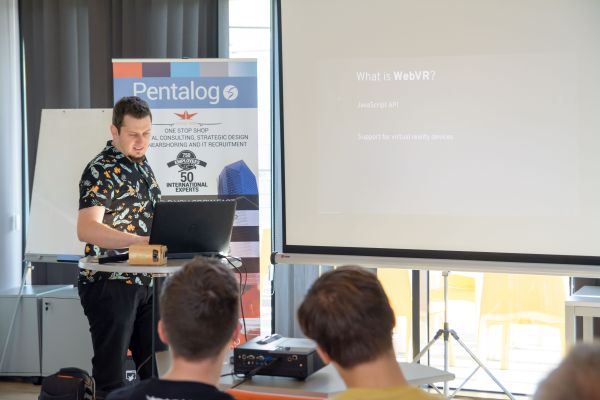Surely you’ve played a video game that felt so real that you wanted to pinch yourself. Or maybe you’ve watched the birth of a tornado on a meteor website just for fun. The world’s allure and obsession with Virtual Reality has companies the world over investing millions into web VR development.
VR’s Massive Support through Investments
Worldwide revenue for the augmented reality and virtual reality markets are projected to approach $14 billion in 2017, according to IDC – and balloon to $143 billion by 2020. Facebook, Google, Microsoft, & Apple (to name a renowned few) are gunning to be at the forefront of the path to VR discovery and dumping hundreds of millions into the technology – a number inducing the same nauseating effects as those darn 3D headsets.
But, people live for this stuff! VR hardware sales alone are expected to reach $2.4 billion in 2017 while VR software sales are estimated to grow up to $2.8 billion by 2018, according to virtual reality consulting firm KZero.
Client-side companies are catching onto the spell virtual reality has cast over its consumers and are now making moves with IT companies that can develop VR applications and websites for their products. This upgrade introduces a technological savvy that is user-friendly at the same time.
For example, Web VR has the potential to outsell a top notch realtor by virtually immersing the client into a property with just the use of a headset. This would mean a prospective buyer could survey a home in California – from the comfort of their home thousands of miles away in NYC. Using their movement to activate sensors, they could explore the property live from a number of different angles – as they would in person.

Source: oculus.com / Oculus is making it possible to experience anything, anywhere, through the power of virtual reality.
The scope of Virtual Reality has already expanded to reach fields like retail, gaming, hospitality, education and architecture engineering – to name a few. No other technology thus far has gifted consumers with the same convenience of seeing the product they want to purchase, the hotel room they will stay in or the house they will live in all without not having to be physically there.
Immersive Computing Changes Lives
Despite some misconceptions, Web VR is nothing new. People have been talking about using Web GL to render interactive 3D graphics in the browser for over half a decade, in various different implementations. What is new, however, is the availability of open source libraries that can be used even by novice developers in order to build VR experiences in very little time.
Web VR is an open standard (JavaScript API) that makes it possible to experience virtual reality in your browser although web browsing wasn’t exactly made to be viewed from a VR perspective. It does, however open possibilities for more content in the future. VR-focused browsers have started emerging to make it easier for everyone to get into VR experiences, no matter what device is being used. In order to experience Web VR, you need two things: a headset and compatible browser.
This API is designed with the following goals in mind: detect available Virtual Reality devices, query the device capabilities, poll the device’s position/orientation and display imagery on the device at the appropriate frame rate.
In terms of browsers that support Web VR, these are what’s on the market:
- Mozilla Nightly (desktop)
- Chronium (desktop)
- Samsung Internet (mobile)
- Google Chrome (mobile)
- WeChat (mobile)
- Oculus Carmel (HMD)Regarding headsets, you can use:
- Oculus Rift – a virtual reality headset developed and manufactured by Oculus VR, a division of Facebook, released on March 28, 2016.
- HTC Vive – a high end virtual reality headset developed by HTC and Valve Corporation, released on 5 April 2016
- Samsung Gear VR – a mobile virtual reality headset developed by Samsung Electronics, in collaboration with Oculus, and manufactured by Samsung; the headset was released on November 27, 2015.
- Google Daydream View – was announced on October 4, 2016, as the first headset for Daydream.
- PlayStation VR – a virtual reality headset developed by Sony Interactive Entertainment, launched on October 13, 2016.
- Google Cardboard – a virtual reality platform developed by Google for use with a head mount for a smartphone.

We discussed Virtual Reality and Web VR at PentaBAR #21 #Brasov, a knowledge sharing event where all IT enthusiasts are welcome.
“In terms of controllers, for Oculus Rift and HTC Vive you’ll find them in the same package, while Samsung Gear VR and Google Cardboard use smartphones for display and sensor, says Laurentiu, Pentalog’s Front-End Developer. Also, regarding web frameworks for building virtual reality experiences, Laurentiu would recommend A-Frame as the best choice “because it is based on top of HTML, making it simple to start with”. “It also has support for most VR headsets (Vive, Rift, Daydream, Gear VR, Cardboard) and can be used even for augmented reality. There are lots of current examples that can be used for inspiration.”, Laurentiu says.
Other popular frameworks and libraries for building VR websites are React VR (great for both experienced developers and beginners alike ) and Three.js (the library used by A-Frame at its core, recommended for more experienced developers).
VR Creates Social Experiences
Immersive computing is undoubtedly changing the way we play, work, live and learn. It’s put us at the brink of a new computing revolution. With Web VR, you get all the benefits of the Web: it’s searchable, linkable, low-friction (no installation required), and shareable. With all the tools available and the current industry growth – there has never been a better time to start building!
Laurentiu was the host of PentaBAR #20 Brasov, an IT knowledge sharing event that we traditionally organize on a regular basis, after work, in order to discuss recent innovation or other IT related topics.
Interested in developing a VR app with Pentalog? Contact us and see what we’ve done in this field so far.

 (18 votes, average: 4.94 out of 5)
(18 votes, average: 4.94 out of 5)




